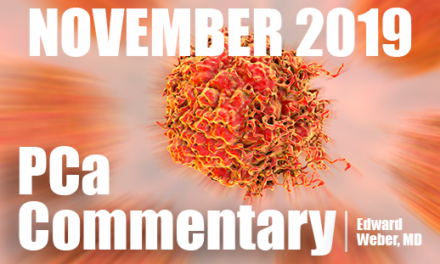
PCa Commentary | Volume 136 – July 2019
Posted by Edward Weber | July 2019
The Natural History of Prostate Cancer and the Prognostic Utility of PSA Doubling Time.
We are indebted to UroToday for making available online the informative presentation at ASCO 2019 by Dr. Catherine Marshall: “Outcomes of Men with Recurrent M0 [Metastasis Free] Prostate Cancer who Defer Androgen Deprivation Therapy until Metastasis — Medical Oncologist Perspective” (Catherine Handy Marshall, MD, MPH, Assistant Professor of Oncology, Johns Hopkins Medicine, Baltimore, MD). Her analysis reports the most recent summation of outcome data from three retrospective related observation trials involving men treated with radical prostatectomy at Johns Hopkins between 1981 and 2017. The study records the post-surgical outcome of men followed after biochemical relapse without hormone therapy until evidence of metastases, and who then received the best current therapy available until death. It is unlikely that comparable data will again be collected.
This report offers a unique perspective on the totality of men’s cancer experience, the full scope of which is not easily conceptualized from smaller studies. Contemporary randomized trials typically focus on only a small portion of the clinical course. For example, researchers may begin a trial at the onset of castration resistance, complete a study with the endpoint of metastasis-free survival, or compare therapies for men already harboring metastatic castrate resistant disease.
The 2019 report analyzed the outcomes of 1686 men: 79% had Gleason score 7 or lower, 21% Gleason score 8 or higher, and 41% had received salvage radiotherapy. The median follow-up time was 10 years (interquartile range 5 – 16 years); median age, 60 years; and for the entire group the overall PSA doubling time was 33 months.
A calculation of clinical relevance was the analysis of outcomes into subsets of PSA doubling times of <6 and <10 months. Of the 29% who developed metastatic disease during follow-up (n = 489 men), 61% had a PSA doubling time of <6 months and 55% had a doubling time of <10 months. Metastasis-free survival was based on the time interval from PSA recurrence to initial metastasis, established by CT and bone scans.
The most clinically relevant data was captured in results reporting median metastasis-free survival (MFS) and overall survival (OS). For men with PSADT <6 months, the MFS was 9 years, and for OS, 13 years. For men with PSADT <10 months, MFS was 12 years and OS 15 years.
Probably the most startling data were the MFS and OS of 21 years and OS 22 years describing the entire study group. Not surprisingly, “age, Gleason score, and stage at the time of radical prostatectomy, and receipt of salvage radiation therapy were most associated with overall survival.” Dr. Marshall made note of the close time interval separating overall MFS and OS, i.e., about 1 year. Considering that, in recent years, therapies would have included agents such as Xtandi and Zytiga, this similarity was a bit surprising. [By using more sensitive imaging, e.g., the PSMA and Axumin PET/CT scans, metastases would have been diagnosed earlier.]
Two points of interest:
In the ASCO analysis, biochemical progression following surgery was set at >0.4 ng/mL, not at the customary threshold of >0.2 ng/mL. This 0.4 ng/mL metric is chosen by researchers at the Mayo Clinic who contend that “PSA 0.4 ng/ml or greater may be the most appropriate cut point to use [for PSA progression after radical prostatectomy] since a significant number of patients with lower PSA do not have continued increase in it [observed at 5 year follow-up]” (Amling et al. J. Urol. Apr 2001).
The absence of further subdividing outcome data according to Gleason score or a subset based on time from surgery to biochemical recurrence is explained by the fact that PSA doubling time is the strongest predictor of metastasis and captures the influence of both of these elements.
The earlier studies:
The first report on this series was in JAMA, May 1999, by Patrick Walsh et al. and was based on 304 men (131 with PSADT data).
The second report on this natural history study of metastatic progression after surgery appeared in BJU Int., 2012 Jan, authored by Antonarakis et al. describing the outcome of 672 patients
(450 with PSADT data) followed between 1981 and 2010 at Johns Hopkins. Metastatic disease was established on CT and bone scans. In their study, the lowest risk of death was associated with PSADT of >15 months. The utility of establishing the relationship of PSADT and MFS was supported by the observation that “identifying and treating patients at the highest risk of metastases would probably have the greatest impact on patient outcomes …” This predictive effect of PSADT is independent of the type of local therapy, surgery or radiotherapy.
Antonarakis concludes: “Finally, the present study provides further evidence that PSADT is the strongest prognosticator of metastases in men with biochemical relapse, suggesting that this parameter should be calculated in all such patients.”
BOTTOM LINE:
Awareness of the natural history of prostate cancer offers perspective; awareness of the PSA doubling time provides guidance in selecting the most appropriate time to initiate hormone suppression so as to balance the dual goals of delaying metastases and avoiding the toxicity of therapy.
Your comments and requests for information on a specific topic are welcome e-mail ecweber@nwlink.com.
Please also visit https://prostatecancerfree.org/prostate-cancer-news for a selection of past issues of the PCa Commentary covering a variety of topics.
“I want to thank Dawn Scott, Staffperson, Tumor Institute Radiation Oncology Group, & Mike Scully, Librarian, Swedish Medical Center for their unfailing, timely, and resourceful support of the Commentary project. Without their help this Commentary would not be possible.”




